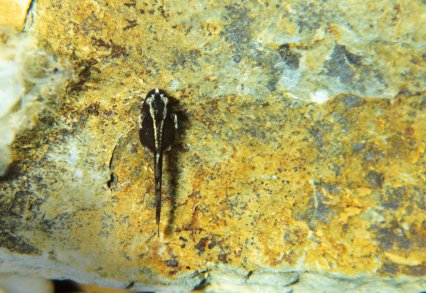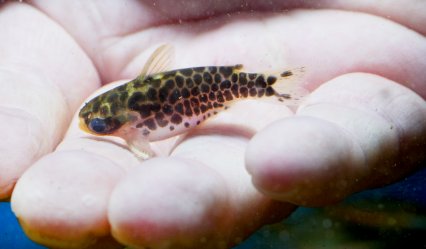Bob Mehen suggests five straightforward breeding projects, involving some of the most rewarding species for catfish lovers.
There’s little more satisfying for a fishkeeper than breeding your own fish. It can offer fascinating insights into species we keep and, if nothing else, shows you’re probably doing something right.
There are thousands of catfish species worldwide and this diversity is down in no small part to their ability to adapt to a vast range of conditions.
While encouraging some catfish to breed can present major challenges to even the most experienced fishkeeper, many species will fill your tanks with the pitter-patter of tiny fins — given just a few simple stimuli. There’s usually a market for good quality, home-bred catfish too.
All the better reason, then to consider the following projects...

The easiest first!
Corydoras are among the most popular cats. The most commonly available and cheapest species are Bronze and Peppered cory (Corydoras aeneus and C. paleatus) and, given the ease at which these will reproduce, it’s not surprising!
Both are community staples and will often breed with no encouragement, and if their tank mates are not too big a few eggs and fry may survive without your intervention. However, your help will increase success rates in breeding and raising fry.
Adding a group of mature fish to their own breeding tank at a ratio of at least two males to each female is a good start.

Females of both species are considerably bigger and broader than males. Feed them up with a range of quality foods — live and frozen being ideal — after which spawning can be triggered by daily changes of around 50% with water at some 5°C/9°F less than that in the tank until they oblige.
You should notice the females being pursued by amorous males until they adopt the characteristic ‘T’ position, with a female’s head near the male’s vent. She will hold small groups of freshly laid and fertilised eggs between her ventral fins and search for a suitable place to deposit them. The sides of the tank, filter, rocks and plants can all be chosen sites, so include a range of décor.
Once breeding has finished, remove the adults or move the eggs to a suitable tank for hatching and rearing. The eggs will typically take between three and five days to hatch, but remove any unfertilised ones which may get covered in fungus and contaminate fertilised ones.
It takes about four days after hatching for the fry to absorb their yolk sacs and become free swimming, at which point they’ll need suitably tiny foods. Within three months you should have 2.5cm/1” replicas of their parents.

Bristling with pride
Many fish show amazing parental care and the common Bristlenose catfish (Ancistrus sp.) is a prime example. Males and females are easy to tell apart, as mature males have an impressive growth of 'bristles' — soft, tentacle-like structures — over their heads.
Depending on species the females are less hirsute, with either a daintier row around the edge of their noses or none at all. Once you have a settled pair breeding is almost guaranteed. All they need is a good diet and water conditions, and a suitable cave or hollow log to call home.
Males will guard their cave, only standing down to allow a female in to lay eggs. Once typically 50 eggs have been deposited she will have nothing else to do with her progeny, swimming off to allow the male back to fertilise the eggs which he cares for alone, constantly circulating water over them with rhythmic fin flapping.


The orange eggs take some five days to hatch and the male will carry on guarding until they’ve used up their yolk sacs. Once free swimming he usually starts to lose interest and the fry will spread out in search of food. Blanched cucumber slices are an ideal starter.
These parents will not harm the fry, so there’s no need to remove them.

Bubbly babies! (Picture by Chrumps, Creative Commons)
Looking like animated armoured sausages, Hoplos (Megalechis thoracata) may not be the epitome of piscine grace but males are pugnacious, protective parents. Those in breeding condition are easy to distinguish from females, thanks to thickened, orangey-red pectoral spines.
These fish can also be triggered into spawning by a large, cool water change. At this point the male will start to build a large bubble nest at the surface — so provide floating plants to help him.
The pair will deposit fertilised eggs in this frothy cradle. She may need to be removed at this stage as he can become quite aggressive towards allcomers, even splashing water at nosey fishkeepers!
Eggs take about four days to hatch and the fry become free swimming after another two — at which point the male can be a threat so fry are best removed.
Hoplo fry are as voracious as their parents and will need constant food, such as newly hatched brineshrimp, but, given appropriate nutrition, they will reach a saleable 1.5”/4cm inside a couple of months.

Royal lineage
If on the lookout for another loricariid lothario consider the Royal whiptail (Sturisoma aureum). There’s always a market for the comical, twig-like youngsters among those who don’t want plant-munching monsters.
Males develop a 'stubble' of odontodes on the sides of their head and females tend to be broader and bulkier.
Males will also tussle over females, so while these can be kept in groups, given sufficient space, get at least two females to each male. They don’t tend to seek out a cave in which to lay their eggs, instead looking for a secluded area and placing their eggs on wood, a plant leaf or often on to glass itself.
As with the Ancistrus, the male will stand guard by the eggs, covering them and fanning them with his fins.
Eggs take from four to eight days to hatch, after which the fry will live off their yolk sacs for a couple of days.

At this point having food nearby is vital. The fry are 'lazy' and seem either unwilling or unable to search over any great distance, so will rapidly starve if not offered nearby fodder.
They are constant grazers and will love blanched cucumber and other easy vegetable foods. The parents can be safely left with their youngsters too, as long as competition for food isn’t that fierce.
The fry soon resemble miniatures of their parents and their apparent laziness is probably down to an instinct to stay as still as possible and make their twiggy disguise more convincing.
These are an ideal breeding project for a well-planted tank, as there will be plenty of shelter and grazing opportunities for the young.

Mother knows best
Wood cats used to be considered classic ‘brown catfish’; seldom seen, largely nocturnal and generally dull and brown. Luckily this myth is eroding and the popularity of the Oil catfish is gathering pace.
Centromochlus perugiae must be a factor in this renaissance. These are not only pretty, with a bold, giraffe-like patterning, but also relatively straightforward to breed, and at only 6cm/2.5” you won’t need a massive tank.
Oil cats have different breeding behaviours to the other fish featured here. In a manner similar to livebearers, such as guppies, the male has an adapted anal fin with which he fertilises the eggs internally before the female lays them. This act is the end of his parental involvement.
The female will then search for rocky caves and crevices in which to lay the eggs and will guard them for the time it takes them to hatch and become free swimming — typically around a week.
In the wild these fish live in shallow, rocky rivers and need reasonable flow in the aquarium to encourage spawning. Caves can be rocks, slate, hollow wood or plastic piping and a selection should offer the female plenty of choice.
Once the fry have hatched the parents are best removed as they will eat their offspring. The fry tend to spend much of their time near the surface, so provide floating plants, twiggy branches and other forms of high-up cover. Like mum and dad they’re nocturnal, so feed them at night time. Microworms and brineshrimp nauplii are ideal first foods, but the greedy young will soon want bigger fare.
12 steps to becoming a better breeder
1. A dedicated breeding tank will definitely increase your chances of success.
2. Offer good nutrition to bring the parents into breeding condition.
3. Have suitably tiny foods ready for the hungry arrivals.
4. Many cats can be tempted to ‘perform’ by a big, cool water change.
5. Check your water suits prospective parents. Too hard and alkaline and they may not breed in it.
6. Parents fastidiously caring for and defending their eggs can soon decide their fry look tasty! Remove eggs/fry/parents as appropriate.
7. Clean conditions and regular water changes are vital for fry.
8. Air-powered foam filters are perfect in breeding tanks, providing both gentle filtration and a source of nutrients.
9. Bare-bottomed aquaria are not always best for raising fry. These often do better above a thin layer of fine sand.
10. Choose quality breeding stock. Sourcing fish from more than one location can help prevent inbreeding, but buy all of the same species to prevent hybrids.
11. Given suitable tank mates and décor, many can be successfully spawned and raised in community aquaria.
12. Check with your local shop to see if staff would take species you plan to breed before filling your tanks with unwanted 'kittens'.
Why not take out a subscription to Practical Fishkeeping magazine? See our latest subscription offer.
Don't forget that PFK is now available to download on the iPad/iPhone.







